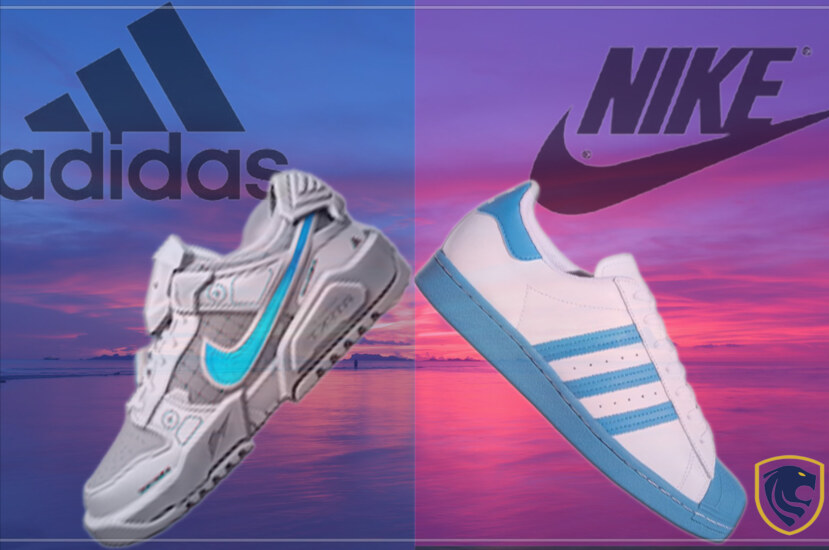Nike spent years researching and developing a range of footwear, apparel, and equipment. Nike initiated the “Just Do It” campaign in 1988, conveying a sense of simplicity and showing that their belief was in the individual (the power is within). They started to produce posters that featured sponsored athletes. In 1991 Nike had become synonymous with sports throughout North America.
buying Air Jordans
In 1994 Nike bought up Air Jordans for $200 million from basketball player Michael Jordan’s footwear company. The deal included lifetime royalties for Jordan. The shoes initially sold for $125, but within a few years, the price had fallen to $60. And in early 2006 to just $40 in North America. That made it one of the biggest selling shoes ever. The success of Nike with their Jordan range demonstrates the power that celebrity endorsements can have over consumer behavior and how they attract different target markets.
Adidas had a significant advantage when they entered the running shoe market as they were already very successful in other sports such as football (soccer) and handball. However, Adidas did not move into skateboarding and many other activities until it was too late, and Nike already dominated these sports.
In 1995 the Swoosh was a dominant force in virtually all sports. Nike’s strategy was to be involved in as many different types of sport as possible, but Adidas focused on fewer sports and became very successful within the football industry. By 1997 Adidas had grown to become the world’s largest seller of football boots.
Adidas decided to market its products in a single way designed by ‘styling experts’. The brand used the deep tones that were common at that time across most of their ranges with simple yet dynamic designs across all products. This lack of differentiation made it difficult for consumers to recognize differences between products and forced them to pick up individual items to make a choice on quality.

Air Jordans
Adidas’s sponsorships for football
Adidas had also been using their sponsorship of the international football team, Germany, to market their products. The German Football Association was a strong ally of Nike, so Adidas’ share prices fell. Although Adidas’ shoes were priced lower than Nike’s, the company’s market share remained low.
Nike began producing athletes’ clothes and developed new materials for high-performance clothes. They changed their pricing policy by making footwear cheaper and shirts more expensive, resulting in an increase in sales of these things rather than trainers, which remain their best-selling items.
Lunching the Brand Jordan
In 1997 Nike launched ‘Brand Jordan,’ giving Michael Jordan royalties of 20 percent on all sales of Air Jordans. This gave him the incentive he needed to expand his career and become more involved with Nike. By the year 2000, 90% of professional basketball players were wearing Air Jordans.
Nike P.I.D
In 1998 Nike released its new running line, ‘Nike P.I.D.,’ an acronym for Personalized Innovative Design. These shoes were very successful amongst young people because they appealed to their tastes in music, fashion, and art.
By 1999 Nike had become a world leader in sports, and the market share of its running shoes was more than twice that of its closest competitor.
Adidas launched ‘Torsion
In 2000 Adidas launched ‘Torsion,’ a new advanced design for football boots. The German Football Association (Nike sponsored) had been wearing Nike boots for many years. So, Adidas believed that this would help them gain market share where they were losing out to Nike. However, even though the German team won the European Championships with these new boots, it did not affect their sales figures overall.
By 1996 Nike was the largest manufacturer of athletic shoes in the United States, with a market share of 67%. In Europe, they had 80% of the athletic shoe market. Although Adidas dominated sports footwear at that time, Nike had surpassed the company in sales of athletic shoes.
In order to achieve this, Nike developed new marketing tools and schemes, such as the key focus on athletes. This strategy has allowed Nike to create a strong brand image amongst young people and appeal to their aesthetic choices.

Adidas launched ‘Torsion
The first thing that Nike did was they went out and got some celebrities. The ones who had become successful by becoming athletes in different sports such as football or running. Nike introduced shoes that were designed specifically for their athletes, such as the AD Rukus, which basketball player Shaquille O’Neal designed. The AD Rukus was a shoe that all basketball players wanted to wear because of the success of Shaquille O’Neal.
targeting specific market segments
Nike’s next marketing strategy was to target specific market segments and develop a particular type of product for them. This was achieved by Nike doing market research into what their consumers wanted from their products and creating specific products in response to this. Then they gave their products the right names and designed them around this.
Nike called their running shoes ‘P.I.D.’, which stood for ‘Personalized Innovative Design.’ The Nike P.I.D. The line of running shoes was made to look good, fit well, and last longer. Because they were designed by a stylist rather than by engineers or scientists. These sneakers were more expensive than other runners. And the way they are produced makes them better quality than the others.
Nike launched a new shoe style for men in 1996 called the Nike P.I.D. It was the first time that a stylist had been given the job of designing a shoe rather than a mechanic. So, Nike could appeal to young people’s aesthetic tastes. Nike used this to their advantage by marketing the P.I.D. The line to young people, and also market research was done about what qualities that young people thought were important in a shoe, and these were: this was so that young people would buy the products because they liked their looks and the way they felt on their feet.
This is an example of a Nike P.I.D. shoe, it has all the qualities that young people like which results in its popularity among them, it is also good value for money as when compared to other running shoes it’s relatively cheap, but then again they are better quality and last longer due to the fact stylists rather than engineers or scientists have made them
price differentiation
Another strategy that they used was price differentiation. Nike realized that people were not buying Nike products because they were expensive. But because they were fashionable and of good value. By focusing on designing great-looking shoes with high-quality components and also by developing new technology in their shoes, Nike was able to create a range of products. Those appealed to young people who were busy and had little time to spend shopping.

Nikefootwear
For example, the Nike P.I.D range of running shoes has been designed by a stylist and then re-designed when made; the shoe’s technology is quite amazing as it has a self-lacing system. That makes them very easy to put on and take off. The technology inside the shoe is also very different from some other running shoes on the market.
Nike has been able to continue to be successful in the sports apparel industry. this is because of their continued research and development. There are three factors that help to drive Nike’s research and development: an increase in competition, a growth in sales, and an increase in environmental pressures.
The success that Nike has generated from their design of running shoes gave them the funds they required to invest further into research and development. This investment led Nike to improve the design of more athletic shoes, such as basketball boots.
Nike was able to cement its position at the top of the sports apparel industry. Nike had been concentrating on its four key factors: research and development, product differentiation, marketing, and brand management. The company’s focus on these four areas has allowed it to generate a strong presence in the sports apparel market. These strategies have been profitable for Nike as their return on investment has increased from 12% to 17%.




